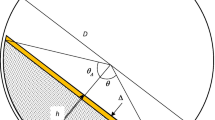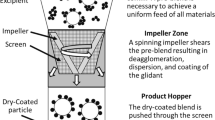Abstract
In this study, we describe the use of an innovative imaging system to measure and control the effect of nozzle operating parameters on the characteristics of a spray. These characteristics, including spray pattern, droplet size distribution, and droplet velocity, define the quality of the spray. They can have significant impact on the efficiency of the pan coating process and the quality of the coat. Suspensions of different composition were used in this study, and the authors demonstrated that the spray characteristics can be controlled with this approach.
The main conclusions from this study were:
-
1.
The AA/Spray (atomization air/spray rate) and AA/PA (atomization air/pattern air) mass flow ratios were the key parameters that affect spray characteristics. Although viscosity can impact the spray, there was minimal impact within the viscosity range tested in this study.
-
2.
With proper selection of the AA/Spray and AA/PA mass flow ratios, it was possible to generate sprays with consistent spatial distributions of volume flux with minimal variations of mean droplet size over the range of coating suspensions and spray rates studied.
Spray characterization can be a powerful tool for exploring and establishing the design space of nozzles operation in the pan coating process. When scaling or transferring a spray coating process, the focus should be on maintaining consistent spray qualities rather than limiting nozzle operating parameters to a range. This approach embraces the FDA concept of process analytical technology (PAT) and design space (FDA, Guidance for industry PAT—A framework for innovative pharmaceutical development, manufacturing, and quality assurance, 2004) for science-based operation flexibility.

















Similar content being viewed by others
References
FDA. Guidance for industry PAT—A framework for innovative pharmaceutical development, manufacturing, and quality assurance; 2004 (September).
Turton R, Cheng XX. The scale-up of spray coating processes for granular solids and tablets. Powder Technol 2005;150:78–85.
Muller R, Kleinebudde P. Scale-down experiments in a new type of pan coater. Pharm Ind. 2005;67(8):950–7.
Rege BD, Gawel J, Kou JH. Identification of critical process variables for coating actives onto tablets via statistically designed experiments. Int J Pharm. 2002;237:87–94.
Ruotsalainen M. Studies on aqueous film coating of tablets performed in a side-vented pan coater. Dissertation, Department of Pharmacy, University of Helsinki; 2003.
Lavernia EJ, Wu Y. Spray atomization and deposition. 3rd ed. Chichester: Wiley; 1997.
Scattergood LK, Cunnungham CR, Vesey CF, Fefely KA. Optimization of spray-nozzle performance for aqueous film-coating process, Colorcon Technical Report (www.colorcon.com/pharma/post_articles/opt_spray.pdf).
Shi D, Li M, et al. Rule-based modeling of coating microstructure. Ind Eng Chem Res. 2004;43:3653–65.
Operating Instruction for Schlick spray nozzle model 930/7-1 S35. Orthos Liquid Systems, Inc.; 2006.
Kim KY, Marshall WR Jr. Drop-size distributions from pneumatic atomizers. AIChE J. 1971;17(3):575–84.
Zhou Y, Lee S, McDonell VG, Samuelsen S, Kozarek RL, Lavernia EJ. Influence of operating variables on average droplet size during linear atomization. At Sprays. 1997;7:339–58.
Chigier N. Optical imaging of sprays. Prog Energy Combust Sci. 1991;17:211–62.
Perry RH, editor. Perry’s chemical engineer’s handbook. 7th ed. New York: McGraw-Hill; 1997.
Acknowledgments
Jussi Larjo and Ismo Linden from OSEIR are acknowledged for customizing the commercial system for the spray characterization. Howard Stamato, Charles Van Kirk, Sanjeev Kothari, Howard Miller, and Megan Schroeder are acknowledged for the suggestion of process conditions and support of process equipment. Daniel Hsieh is acknowledged for the help and discussion of nozzle setup and calibration.
Author information
Authors and Affiliations
Corresponding author
Additional information
The authors describe an imaging device that can be used to characterize the pattern, droplet velocities, and droplet size distribution of a spray. This device, used at-line as a process analytical technology (PAT) tool, ensures the consistent performance of spray nozzles used for coating processes.
Rights and permissions
About this article
Cite this article
Chen, W., Chang, SY., Kiang, S. et al. The Measurement of Spray Quality for Pan Coating Processes. J Pharm Innov 3, 3–14 (2008). https://doi.org/10.1007/s12247-008-9022-6
Published:
Issue Date:
DOI: https://doi.org/10.1007/s12247-008-9022-6




